The Cycle of Alexander the Great, a group of stories surrounding the great hero of antiquity, is dealt with at length in H.L.D. Ward’s Catalogue of Romances in the British Museum, along with other legends with classical origins: Apollonius of Tyre, The Destruction of Jerusalem and The Prophecy of the Tenth Sybil. Some of our most beautifully illuminated manuscripts of the Roman d’Alexandre and the Histoire Ancienne, containing the legends of Alexander the Great, have been fully digitised, including Additional MS 15268, produced in Acre in the Kingdom of Jerusalem in the late 13th century.
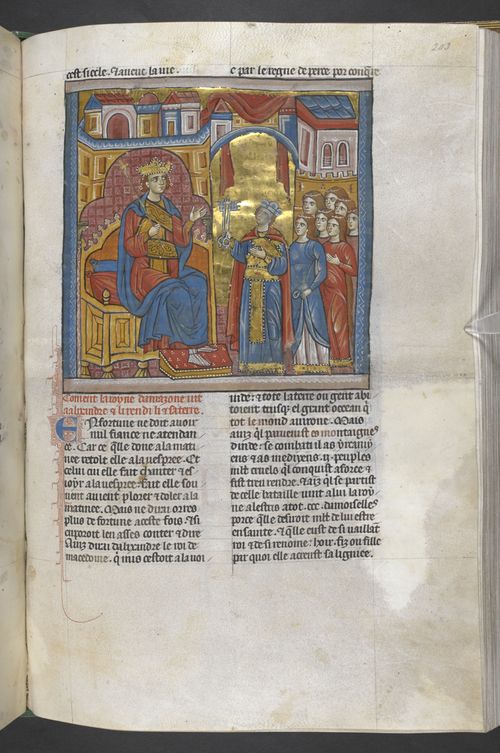
The Amazons surrendering to Alexander on his throne, Histoire Universelle, Acre, late 13th-century, Additional MS 15268, f. 203r
Also digitised are Add MS 19669, Royal MS 20 D I, Royal MS 19 D I and perhaps the most famous of our Alexander manuscripts, Royal MS 20 B XX, which featured in our very popular blogpost Lolcats of the Middle Ages. The young Alexander is often depicted with his father, Philip II of Macedonia, accompanying him on his campaigns.

Philip and Alexander discussing envoys; Philip and Alexander setting out against Armenia; Pausanias and others marching against Philip, Roman d’Alexandre en prose, France, 1333-1340, Royal MS 19 D I, ff. 7v-8r
No earlier forebears are mentioned. In time, though, a popular hero like Alexander needed to have more than one illustrious ancestor, and so a prequel involving a fearless hero, Florimont, his paternal grandfather, came to light.

The Village of Chatillon d’Azergues (Rhone, France), photographed by Milardello, 2009
Aimon de Varennes, a native of Chatillon d’Azergues in the Lyonnais district of France, claims to have unearthed the tale of Florimont during a trip to Philippopolis (now Plovdiv, Bulgaria) in the late 12th century. He may have in fact travelled to that part of the world, but his assertion that he translated the text from Greek to Latin and then into French appears to be fictive, though he retains certain ‘Greek’ words, which in fact demonstrate a very elementary knowledge of the language. The author’s intentions and his claims as to the origins of the tale are laid out at the beginning of the text in Harley MS 4487, one of the manuscripts of the text in the British Library:
Aymez….Fist le Rommans si sagement Aymon conceived the romance well
(f. 3r: column 1, lines 8-9)
Il lavoit en grece veue He had seen it in Greece
……..
A Phelippole la trova He found it in Philippolis
A chastillon len aporta Brought it to Chatillon
Ainsi com il lavoit enpris As he had learned it
Lat de latin en romanz mis He changed it from Latin into Romance
(lines 31-36)
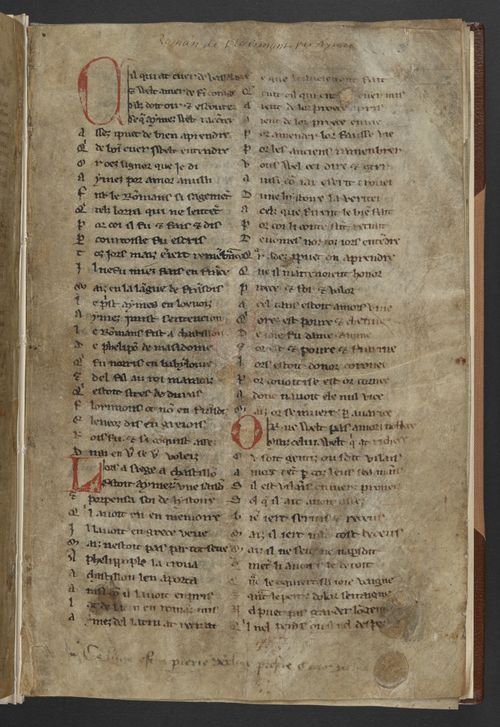
Opening folio with author’s name and 14th century ownership inscription, 'Pierre Derloit prestre ?Corodathis' in the lower margin, Florimont, France, East (?Lotharingia), 1295, Harley MS 4487, f. 3r
The romance of Florimont is in two parts, beginning with the story of the original King Philip I of Macedonia, whose daughter and heiress, Romadanaple married Florimont (‘flower of the world’), son of Mataquas, Duke of Albania. Their son, Philip II, married Olympias and was father to Alexander the Great.

Olympias giving birth to Alexander the Great, with two eagles on the roof of the palace (foretelling Alexander's two empires in Europe and Asia), Netherlands, S. (Bruges); c. 1485 – 1490, Royal MS 20 C III f. 15r
In some versions of the legend, Nectanebus, the last pharaoh, is involved in Alexander’s conception, as depicted in this miniature from a manuscript of the Roman d’Alexandre en Prose.
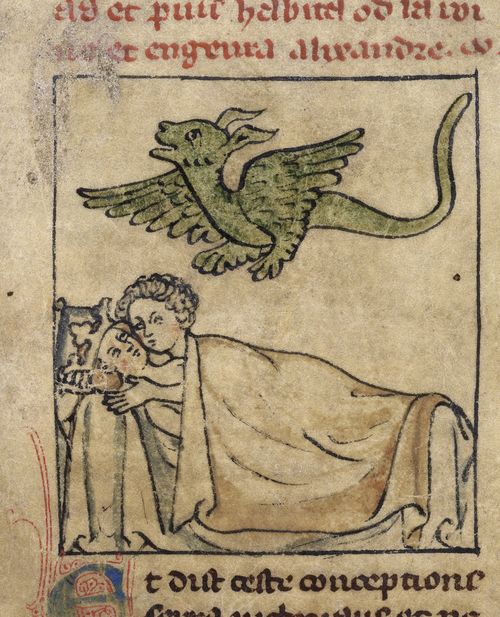
The conception of Alexander, with Nectanebus in the form of a dragon, flying over Queen Olympias and King Philip in bed, Roman d’Alexandre en prose, France, N. or Netherlands, S., 1st quarter of the 14th century, Royal MS 20 A V, f. 6r
The second part of the story tells of Florimont’s victory over the monster terrorising his father’s kingdom and his love for the enchantress of the Isle of Celée, which causes him to reject his birth-right and travel to Albania under the name Pauvre Perdu (Poor lost boy). We do not have an image of Florimont, but here is one of his grandson, Alexander, fighting monsters:

Alexander fighting monsters, Roman d’Alexandre en prose, France, 1333-1340, Royal MS 19 D I, f. 35v
He defeats Camdiobras, king of Hungary, enemy of Mataquas of Albania, and is awarded the hand of his daughter, Romadanaple, together with his lands, which he unites with his own.
Ward’s Catalogue lists two manuscripts of the Romance of Florimont in the British Library. Both have recently been digitised, as, although they are not illustrated, they are important early copies of the text and contain examples of the south-eastern dialect of French. The earliest of the two manuscripts, Harley MS 4487, is dated to 1295 in the scribal colophon and on the previous page the author states that French is not his mother tongue:
As fransois voel de tant server
Que ma langue lor est sauvage
(f. 85v: column 2, lines 13 and 14)

The penultimate folio of Florimont, France, East (?Lotharingia), 1295, Harley MS 4487, f. 85v
The later Harley MS 3983 is written in a neat Gothic cursive of the early 14th century with decorated initials and flourishes in the upper margin.
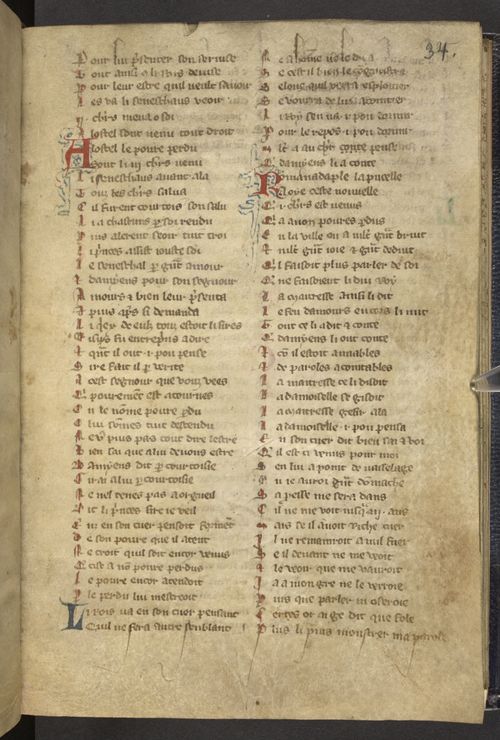
Text page from Florimont with decorated initials at ‘A lostel le povre perdu’ and ‘Romanadaple la pucelle’, France, 1323, Harley MS 3983, f. 34r
Florimont is followed by a French minstrel’s chronicle known as the Récits d’un ménestrel de Reims that begins with the conquest of Antioch by Godefroi de Bouillon and ends with the death of the eldest son of St Louis, King of France, in 1260, including a fable relating to Ysengrin the wolf and Renard the Fox. The manuscript is dated to 1323 in the scribal colophon at the end of the Florimont text.
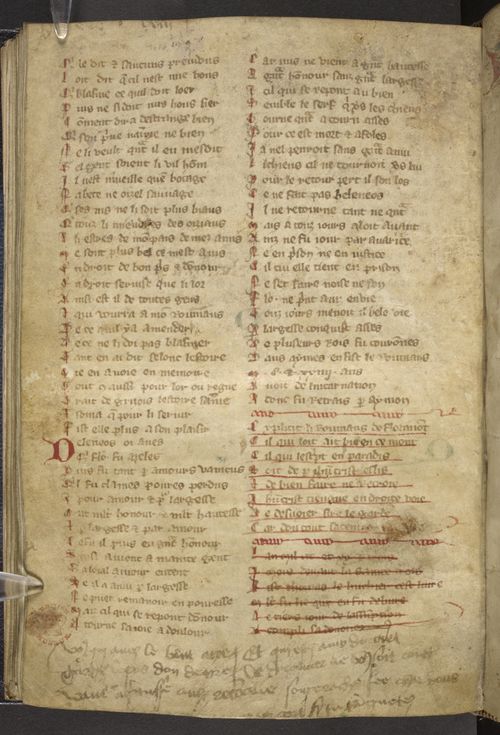
Last folio with colophon, Florimont, France, 1323, Harley MS 3983, f. 81v
There are close to 20 surviving manuscripts of Florimont including several in the Bibliothèque Nationale de France with miniatures illustrating the text.
~Chantry Westwell